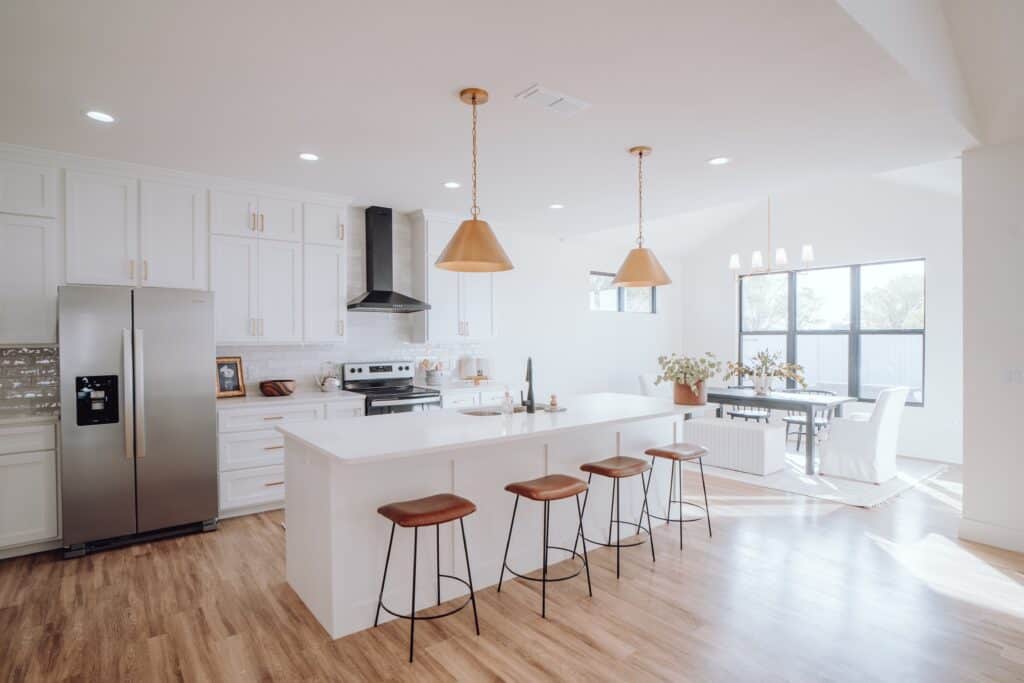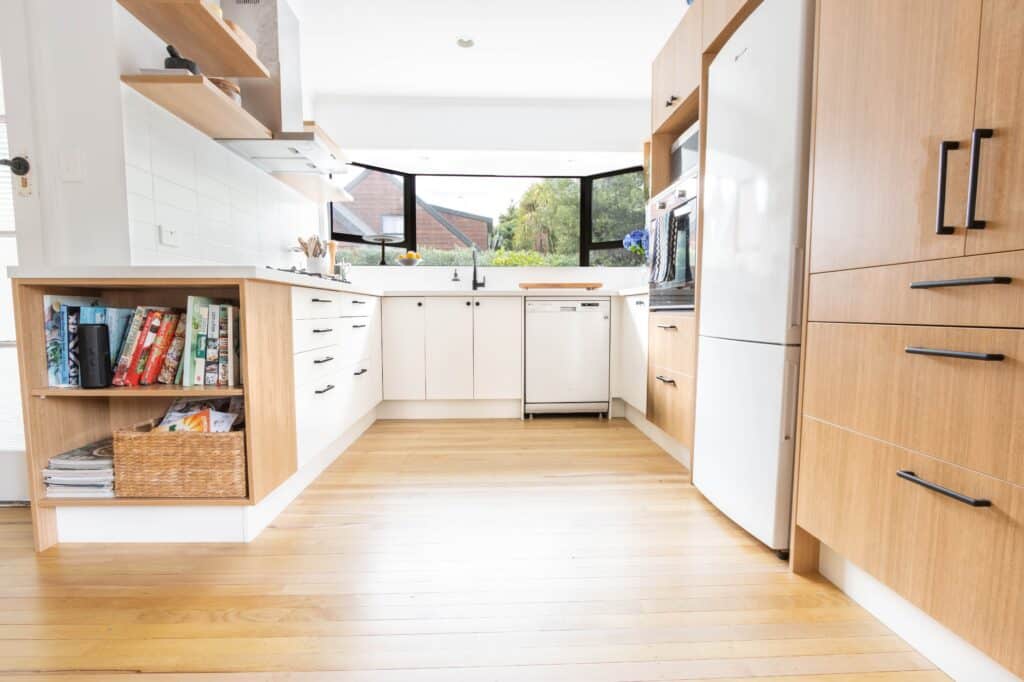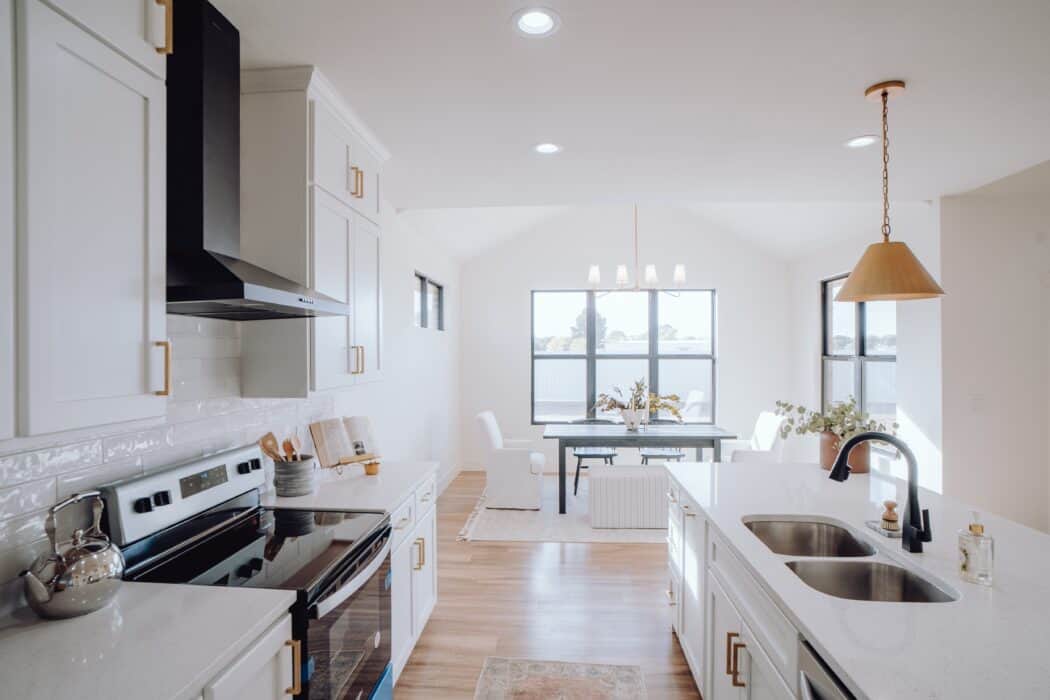The kitchen is the heart of the home. The design of this space can greatly affect the functionality and feel of your living space. One of the most significant design decisions to make when planning a kitchen is whether to have an open or closed layout. In this blog post, we’ll explore the pros and cons of each design to help you make an informed decision for your home.

Open kitchen design
An open kitchen design is a layout that combines the kitchen, dining, and living areas into one large, multi-functional space. This type of layout has become standard in new home construction, and is a popular choice for those renovating or updating existing kitchens.
It is a sought after design trend that offers numerous benefits, with functionality being one of its most significant advantages.
4 Benefits of an Open kitchen concept
- Improved functionality – An open kitchen design facilitates the interaction and communication between the different areas of the home. It allows family members or guests to mingle freely between the kitchen, dining, and living areas without feeling isolated. It also enables the cook to engage with guests while preparing meals, making entertaining more enjoyable and social. An open kitchen design also makes it easier to keep an eye on children. Parents can cook, clean, or work in the kitchen while monitoring their children, which can be a considerable advantage for busy families.
- Enhances natural light – An open kitchen design enhances natural light and airflow, creating a bright, inviting, and more comfortable living space. Natural light can flow freely into the space, illuminating the kitchen and the surrounding areas. This can reduce the need for artificial lighting during the day, leading to lower energy costs and a more eco-friendly home.
- Spacious feel – Without walls or doors blocking the view, an open kitchen feels more spacious, and allows room for movement. This goes beyond just the kitchen, the dining and family rooms also start to feel larger as the dividing walls are eliminated.
- Unified interior design – Finally, I think we can attribute some of the popularity of open kitchen designs to the rise of “foodie culture” and the growing interest in cooking and entertaining at home. This ties back into the first point where the cook can engage with guests while preparing meals, making the whole experience more social and enjoyable. It can even help guests get involved in the prep work without it feeling like a job or task they have been assigned. Where they are relegated to the back kitchen and away from the social group.
A quick note- Do not let the space become too open, as it can begin to feel a bit like an airplane hanger without any definition. To combat this, I like to create visual barriers or visual differentiation to help define each space.
4 Downsides to an Open Kitchen design
- Lack of privacy – If you want to keep dirty dishes and a messy kitchen hidden from guests, look elsewhere. An open concept puts the kitchen on display.
- Noise pollution – With no walls to absorb sound, an open kitchen design can be noisy, making it difficult to enjoy or relax in the space when someone is cooking or cleaning.
- Smell – With a lack of walls smells will travel and spread across the entire space. This could also be a positive if it’s fresh baked cookies. If it’s fish, less so.
- Need for tidiness – Without any walls, kitchens can easily appear messy and cluttered, and can begin to make the rest of the home feel unorganized by association. This is because open concept kitchens do typically come at the cost of less storage space. That being said, a good design can help mitigate some of this problem, by finding a “home” for everything in the kitchen. This eliminates the need to use the countertop as a means of storage.
Are you ready for your dream kitchen?

Closed kitchen design
A closed kitchen design is a traditional layout that features walls and doors separating the kitchen from other areas of the home. While it may not be as trendy as open kitchen designs, it does offer several advantages in terms of functionality.
4 Benefits of an Enclosed kitchen
- Privacy – One of the primary benefits of a closed kitchen design is the privacy it offers. We have seen a shift in the last few years to a work from home culture and many people don’t have a dedicated home office. This means a corner of the living room or the dining table becomes the work space during the day. With walls and doors separating the kitchen from other living spaces, it is easier to maintain privacy and control noise levels. This also works in reverse- the kitchen becomes a quieter and more focused work environment, making it easier to concentrate on meal preparation without distractions.
- Control of smell – Another significant advantage of a closed kitchen design is the improved control of cooking smells. Cooking smells are contained within the enclosed space, making it easier to maintain a clean and fresh-smelling home. Again, this can be a pro or con and is largely dependent on what you are cooking!
- Better function in kitchen – In general, a closed kitchen design provides better storage options than an open kitchen design. This simply comes down to walls. Walls make it easier to accommodate more cabinetry and appliance placements. This can make it easier to keep the kitchen organized and clutter-free, allowing for more efficient meal preparation. However, this is very much design dependent.
- Traditional design – Finally, a closed kitchen design also offers a more traditional and classic look to a home. It creates a sense of formality, which can be ideal for those who like to entertain guests in a separate dining room or formal living room.
5 Downsides of a Closed kitchen concept
- Limited natural light – Closed kitchens can be dark and lack natural light, making them feel cramped and enclosed. This can make it challenging to prepare food or entertain guests, and increase the dependence on artificial lighting.
- Reduced social interaction – With a closed kitchen design, the cook is often isolated from the rest of the family or guests, which can limit social interaction and make it difficult to entertain while cooking.
- Limited airflow – A closed kitchen may not have proper ventilation, which can result in poor indoor air quality and create unpleasant odors. This is easily solved with a proper range vent.
- Reduced resale value – In some cases, a closed kitchen design may not be as desirable to potential homebuyers as an open-concept kitchen, which could negatively impact the resale value of the home. Unfortunately, the enclosed kitchen has become labelled as dated and will affect resale value.
- Higher construction costs – Creating a closed kitchen design typically requires more materials, such as walls, doors, and cabinets, which can increase construction costs compared to an open-concept kitchen design.


No Comments